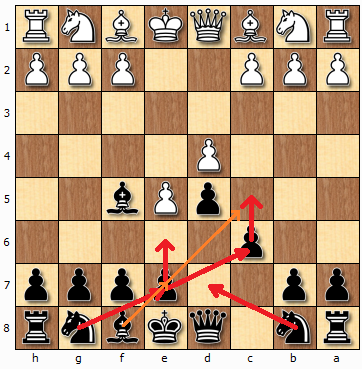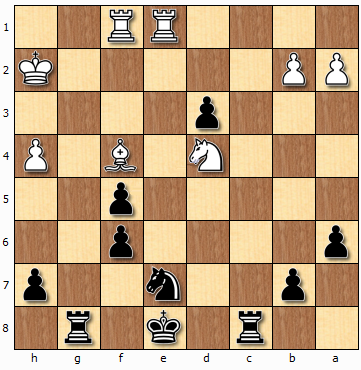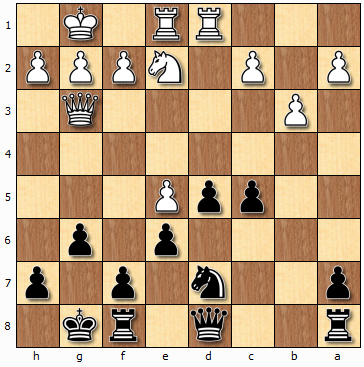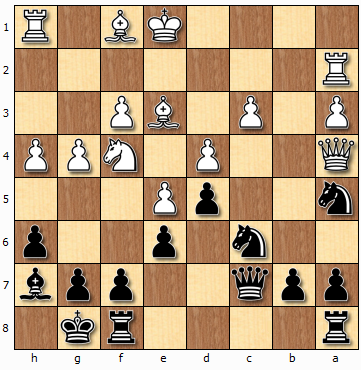19:33 The Caro-Kann defense, Introduce to Advance Variation with 3… Bf5 4. c4 |
|
The advance variation begins with: 1. e4 c6 3. … B f5 What is an idea of the “4. c4” move. In order to understand it let us look at the position after third move of White:
Now the position of Black is very chained. Black has the hugely limited quantity of the abilities for developing its pieces. One of the possible schemes of development is designated by the arrows in the picture above. According to this scheme the Black’s knights move to the d7 and c6 squares (see the red arrows) and the black-square bishop moves either to the e7 square or to the c5 square (see the orange arrows). Let us refer to this way to develop the pieces as the standard development. How this may happen I demonstrate based on the examples of my two games. The game 1 (though White is not convincing here): 1. e4 c6 2. d4 d5 3. e5 B f5 4. N f3 e6 5. B e2 N d7 6. O-O N e7 7. N c3 B g6 8. B g5 h6 9. B d2 c5 10. N h4 B h7 11. N f3 N c6 12. a4 B e4 13. B f4 B x f3 14. B x f3 cd 15. N b5 B c5. =>
The game 2: 1. e4 c6 2. d4 d5 3. e5 B f5 4. N f3 e6 5. B e2 N d7 6. O-O N e7 7. N c3 a6 8. N h4 B g6 9. B g5 Q c7 10. N a4 c5 11. c3 N c6 12. B e3 B e7. =>
The one of key features of standard development is that the Black’s c pawn may move to the c4 square controlling the important central d4 square. In the case of 4. c4, the White’s c pawn takes the Black’s d5 pawn, then the Black’s c pawn takes the White’s d5 pawn. After that, Black loses the feature when its c pawn may control the d4 square. In this situation, the standard development becomes not so preferred for Black and Black has to find other way to develop its pieces. So, the “4. c4” move has two ideas for White. First one is to exchange its c pawn to the Black’s c pawn depriving Black to control the d4 square. Another idea is to prevent the ability of the standard development. Let us make it sure that the standard development is not so good for Black after the exchange of the c pawns. To do this, let us see what happens if Black tries to implement the standard development after the exchange of the c pawns: 1. e4 c6 2. d4 d5 3. e5 B f5 4. c4 e6 5. N c3 N d7 6. cd cd 7. B d3 N e7 8. N b5 and Black threatens to move N d6. That’s why 8. … N c6 and the Black’s bishop controls the d6 square. The game may continue: 9. B x f5 ef 10. N f3 B e7 11. Q d3 and Black loses the f5 pawn as Black can’t play 11... g6 because of 12. B h6 with strong attack. For example, 12. … a6 13. N d6 + B x d6 14. ed N f6 15. O-O Q x d6 16. R ae1 + N e7 17. Q b3 N e4 18. N e5 f6 19. N d3 g5 20. h4 g4 21. B f4 Q d7 22. f3 gf 23. gf R c8 (if 23... N d6 then 24. N c5 Q d8 25. R e6 N b5 26. R ae1 K f7 27. R x e7 + Q x e7 28. Q x d 5+ K g6 29. R x e7 and White wins) 24. fe de 25. N c1 Q x d4 + 26. K h2 R g8 27. N e2 Q d3 28. Q x d3 ed 29. Nd4 and the White's advantage is undeniable: =>
In this game, it’s better for Black 7. … B x d3: 7. B d3 B x d3 8. Q x d3 N e7 9. N ge2 N c6 10. O-O B e7 11. Q g3 g6 (it’s bad for Black 11. … 0-0 because of 12. B h6) 12. B h6 a6 13. R fd1 B f8 (the long castling does not help for Black: 13. … Q c7 14. R ac1 0-0-0 15. Q f3 and Black loses the f7 pawn) 14. B x f8 N x f8 15. N f4 N d7 16. R ac1 O-O with advantage for White: =>
So, we see that the standard development is not good for Black after the exchange of the c pawns. But why White can’t implement the same plan without 4. c4 in the case of the standard development? Why the c pawn is so important? Let us look what happens if White implements this plan without 4. c4: 1. e4 c6 2. d4 d5 3. e5 B f5 4. N c3 e6 5. B d3 B x d3 6. Q x d3 N d7 7. N ge2 N e7 8. O-O c5 9. B f4 cd 10. N x d4 N c6 11. N x c6 bc 12. R fe1 B e7 13. Q g3 g6 14. B h6 B f8 15. B x f8 N x f8 16. N e2 N d7 17. b3 O-O 18. R ad1 c5 with the equal chances: =>
What is difference of the positions in the picture above and in the previous one? In the previous one, White dominates in the center while, in the picture above, Black controls the center. In the both pictures, the White’s queen and the rocks are more active than the Black’s queen and rocks. In the previous picture, the f4 knight looks a bit better than the d7 knight while the c3 knight is equal to the c6 knight. In the picture above, both knights are the same strong. All these factors make the advantage for White in the previous picture and make the position equal for White and for Black in the picture above. Okkey, we understand that the standard development is not good idea in the case of 4. c4. Then how to play for Black in opening in this case? Let us take into account that the Black’s king knight has no chance to be developed but through the e7 square in the advance variation. If so, it looks reasonable for Black to develop the black-square bishop before the development of the king knight because if Black puts the knight to the e7 square it blocks the way for developing the bishop. Thus, the game may continue: 4. … e6 And we get the position with the equal chances:
|
|
|
| Всего комментариев: 0 | |







